St Basil’s Cathedral has become a globally recognised image of Russia. Situated on Red Square beside the Moscow Kremlin, the cathedral is an integral part of Moscow’s city scape and an astounding achievement of ancient Russian architecture, synthesising eleven unique churches into a single ensemble. What is the story behind this monument of Russian spiritual, political, and architectural history, and what can you find there today?
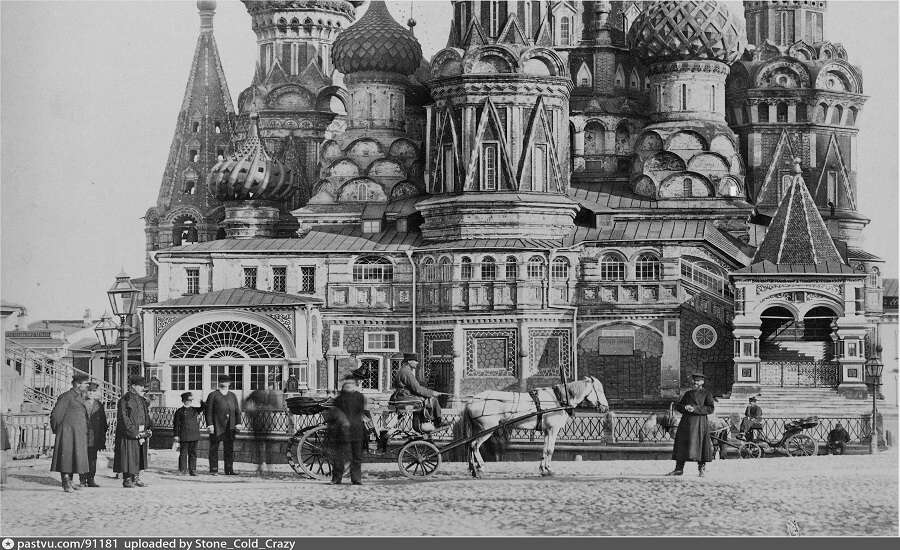
Photo from https://pastvu.com/
The background to the construction of St Basil’s Cathedral was the Kazan campaign of Tsar Ivan IV’s reign, the last in over a century of wars waged between the Khanate of Kazan and Russia. Before his pivotal campaign to capture the city of Kazan in 1552, Ivan the Terrible vowed to erect a cathedral to celebrate Russia’s victory.
After Kazan fell to the Russians on 2nd October, the wooden Trinity Cathedral was constructed, fringed by seven chapels. When the Kazan Khanate finally acceded to the Russian state in 1555, Ivan ordered the reconstruction of the cathedral’s ensemble in stone. No one is certain who exactly designed St Basil’s Cathedral, though it is generally considered to be Russian architects Barma and Postnik.
Did you know? Legend has it that Ivan the Terrible was so impressed by the cathedral that he had the architect blinded, so that its unique beauty and magnificence would never be recreated.
The cathedral was to be rebuilt with eight independent churches encircling a larger central temple. Each church was consecrated in honour of important events in Russian spiritual or political life. St Basil’s Cathedral was completed in July 1561 and consecrated in honour of the Day of the Protection of the Holy Virgin.
Did you know? The central cupola of St Basil’s Cathedralis 65 metres tall. It remained the tallest building in Moscow for 39 years following its completion!
The official name given was the Cathedral of the Intercession on the Moat (Pokrovsky Sobor), but it is more commonly known as St Basil’s Cathedral (Sobor Vasiliya Blazhennogo). Saint Vasily (Basil) was a holy fool and soothsayer, whose miraculous abilities even gained the respect of Ivan the Terrible. Ivan’s son ordered a chapel to be erected in Vasily’s honour, which was completed in 1588 on the site of his grave. The chapel was open day and night and was the only heated church in the cathedral ensemble; soon, it became synonymous with the cathedral as a whole.
St Basil’s Cathedral fell under grave threat during the Patriotic War of 1812. When Napoleon’s army invaded Moscow, they plundered the cathedral and set up stables inside. On retreating from Moscow, Napoleon ordered his chief of artillery to destroy the cathedral; however, the pouring rain extinguished the lit fuses of the explosives.
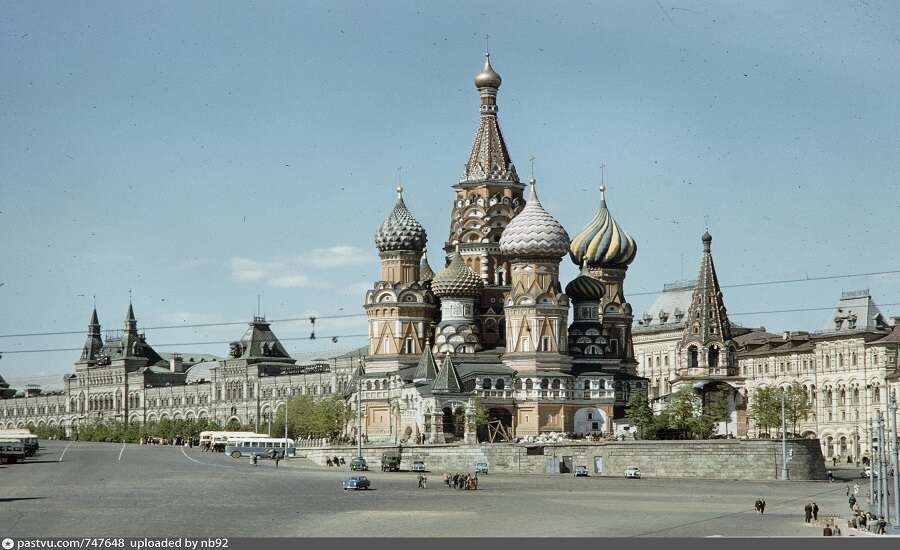
Photo from https://pastvu.com/
The Soviets recognised St Basil’s Cathedral as significant and irreplaceable national monument. It wasdecided to maintain and restore the cathedral, and transform it into a museum with exhibitions about architecture, history, politics, and religion. St Basil’s opened to the public in May 1923, and in 1928, became a branch of the State History Museum, where it has remained ever since.
Did you know? It was rumoured that Ivan the Terrible’s library, a collection of books and documents passed down from the Byzantine emperors, could lie somewhere below the cathedral. Exploration of the cathedral continued well into the 20th century, with archaeologists hunting for treasure, secret passages, and more!
Red Square was used for enormous parades and demonstrations, and under Stalin, various historical buildings were flattened to maximise space there. One of Stalin’s closest associates, Lazar Kaganovich, suggested demolishing St Basil’s Cathedral-Kaganovich had already overseen the destruction of Christ the Saviour Cathedral and the Kremlin’s Kazan Cathedral. However, architect Pyotr Baranovsky begged the Politburo to leave the cathedral untouched, and even sent a telegram to Stalin himself. Baranovsky is credited with saving St Basil’s.
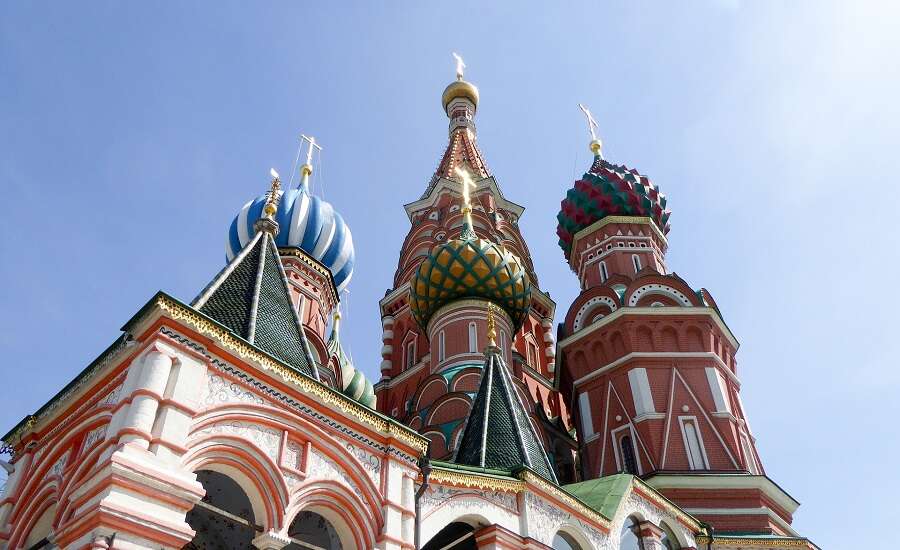
Photo Nicole Pankalla website Pixabay
St Basil’s Cathedral was designated a UNESCO World Heritage Site in 1990. Church services resumed in 1991 and work began to finally bring the cathedral’s bells back to life – today, the bell tower is home to 19 bells ranging from 25 to nearly 500 years old! In 2007, the St Basil’s was declared to be one of the Seven Wonders of Russia.
Today, St Basil’s Cathedral bustles with spiritual and secular activity. Aside from its chapels and church services, the cathedral is also home to festivals, exhibitions, artistic events, concerts, and so much more.
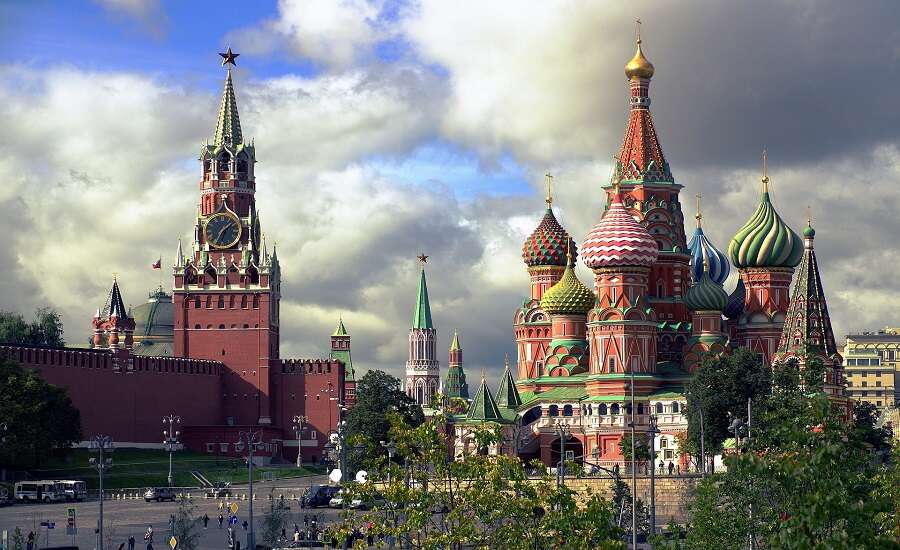
Photo Oleg Shakurov website Pixabay
St Basil’s Cathedral boasts a design unparalleled anywhere else in Russia, indicating the brilliant talent of its creators who dared to break the traditional canons of religious architecture. Its nine towers are crowned with candy-coloured onion domes exuding festivity and cheerfulness. Each tower is embellished with layers ofcornices, kokoshniks, and windows; floral motifs snake up the porches, stairs and galleries; and geometric tiles and patterns punctuate the brickwork.
Originally, St Basil’s Cathedral was not the riot of colour that we see today, but had an austere red and white façade. In the 17th and 18th centuries, successive emperors and empresses significantly modified the cathedral’s appearance. Brick porches and galleries were added, multicoloured paintwork and tiles brightened the façade, and the ornamental domes attained their vibrant colours and design.
Did you know? The domes are covered in 32 tons of 1mm-thick copper sheeting, covering an area of 1,900 square metres.

Photo from https://fotostrana.ru/
St Basil’s is uniquely fascinating for the variety ofarchitectural and artistic styles present in its interior. The wonders to be discovered inside the cathedral include: oil paintings, frescoes, portraits, and landscape painting; iconostases comprising over 400 masterpieces of Moscow and Novgorod iconography from the 16th-19th centuries; and valuable exhibits belonging to the church and imperial family. The cathedral’s chapels are connected via a labyrinth of vaulted internal passages and galleries, which are adorned from floor to ceiling with colourful geometric designs and natural motifs.
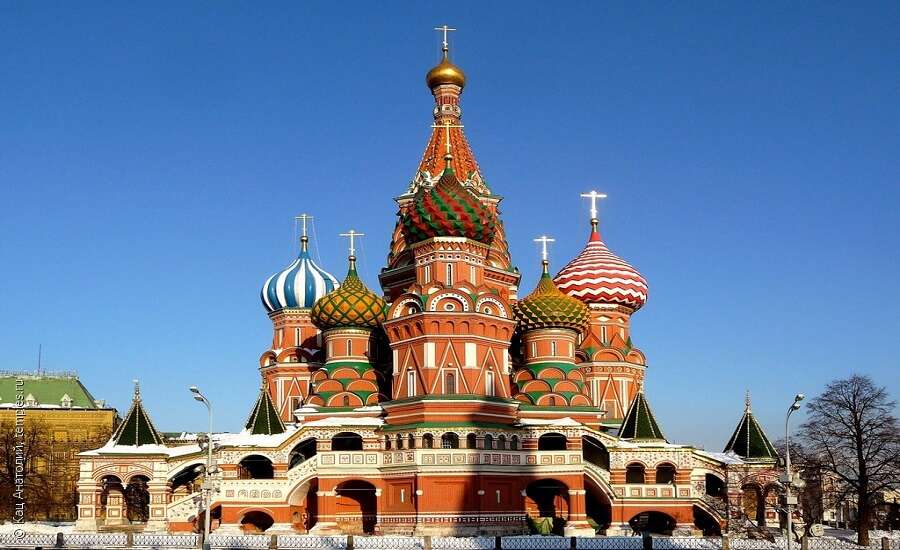
Photo from http://temples.ru/
St Basil’s central chapel, from which the cathedral takes its official name. You can discover the true scale of the cathedral from inside the central church. In some places the original brickwork and painting has been preserved, including an inscription bearing the date of completion of St Basil’s Cathedral (12th July 1561), illuminated by a magnificent chandelier. The huge Baroque-style iconostasis was brought to Moscow in the late 1700s.
The chapel was consecrated in the honour of martyrs Cyprian and Justina, whose memorial day marks the capture of Kazan on 2nd October 1552. White columns lining the octagonal chapel encase bold murals depicting the lives of saints, and stretch towards a central fresco of the Mother of God. A gilded iconostasis in the Classical styleshows scenes of the Creation. The Church of Cyprian and Justina is crowned with a blue and white vertically striped dome.

Photo from http://fotostrana.ru
One of St Basil’s four small chapels, consecrated in honour of Saint Gregory, who was responsible for converting Armenia to Christianity. The demolition of the Arsk tower of Kazan’s fortress in 1552, a key moment in Ivan’s campaign, fell on the saint’s day (30th September). Austere whitewashed walls are offset with a vibrant iconostasis draped with silk and velvet curtains. Also visible are architectural features of the 16th century, religious garments from the 17th century, traditional candles, and an elegant enamel lamp. A grid of yellow diamonds embellishes the exterior dome.

Photo from https://moscowfy.com/
The memory of patriarchs Alexander, John and Paul is commemorated on 30th August, the day on which Ivan’s troops defeated Tatar Prince Yapanchi in 1552. Oil paintings adorning the walls and ceiling depict the patriarchs and other religious figures, and the enormous five-tiered iconostasis is comprised of Baroque and Classical elements. Another of the cathedral’s smaller chapels, its dome is made from green and red rhombuses.

Photo from https://moscowfy.com/
The smallest chapel in the ensemble, but perhaps the most richly decorated, with bright murals portraying religious figures and scenes from the life of Saint Vasily. The construction of the iconostasis was overseen by famous artist Osip Chirikov. It is so large that it stretches along the adjacent walls, and its icons are set into a background of gold, red and blue; two ancient icons are particularly notable: Our Lady of Smolensk and The Image of Saint Vasily the Blessed. The canopy above Saint Vasily’s resting placeis one of the most revered shrines in Moscow.
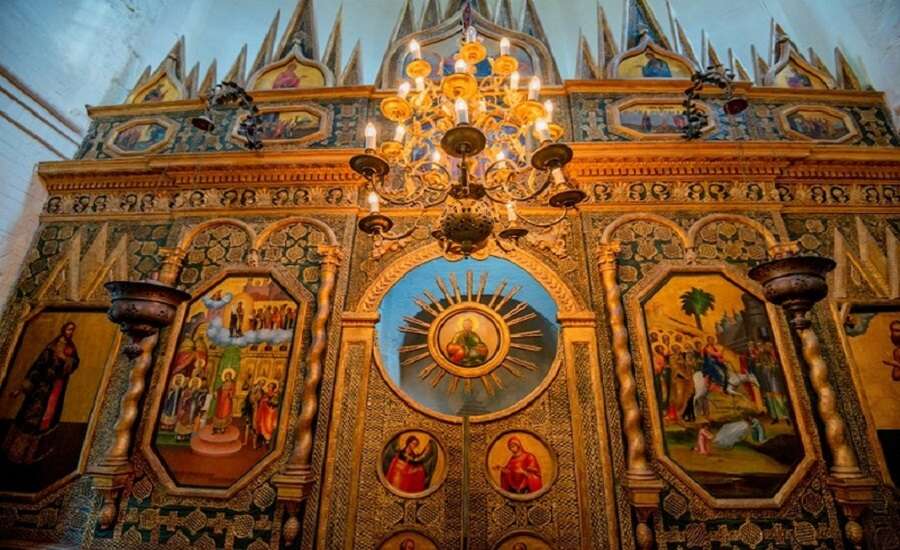
Photo from https://moscowfy.com/
This church celebrates Jesus’s entry to Jerusalem, otherwise known as Palm Sunday. The solemn whitewashed walls are punctuated by original features from the 16th century, and above the northern door visitors can see damage caused by shelling during the October Revolution. The iconostasis of this church was taken from the Kremlin’s Alexander Nevsky Cathedral, and shows scenes from the life of this great Russian hero. The church’s dome is decorated with green and red studs.
The primary doctrine of Christianity is honoured in this church. Its decoration is light, elegant and peaceful and theoriginal architecture and decoration has been almost fully preserved,including the cathedral’s oldest chandelierand one of its most revered icons, the Old Testament Trinity. Cream and green stripes curve towards the pinnacle of the dome, mirroringthe spiral of eternity adorning the dome’s interior. Interestingly, the chapel’s acoustics are augmented by clay vessels inlaid in the walls.
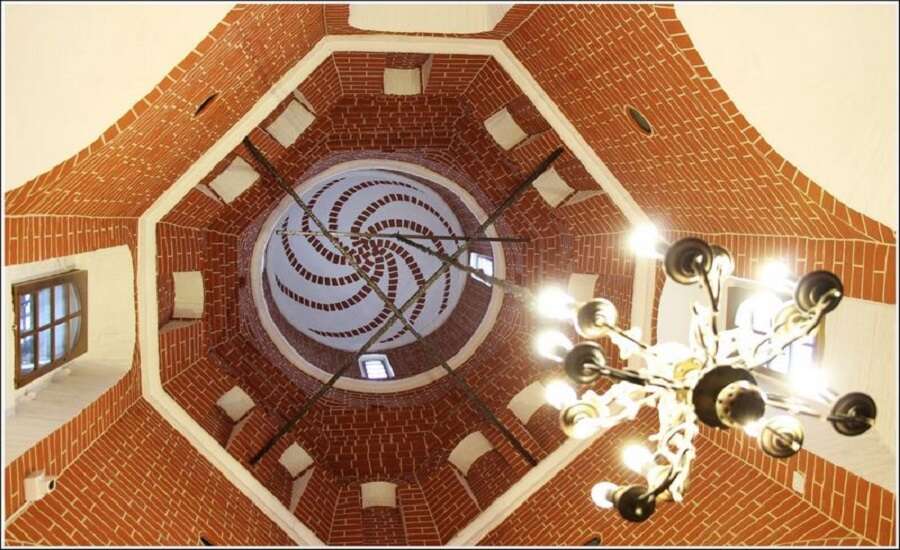
Photo from https://moscowfy.com/
Saint Alexander Svirsky, responsible for converting Northern Russia to Orthodoxy, is celebrated in this little chapel. The memorial day of this saint is also celebrated on 30th August. The chapel’s interior is covered by murals imitating brickwork and the spiral of eternity curls around the interior dome; the exterior comprises green and cream curving stripes.
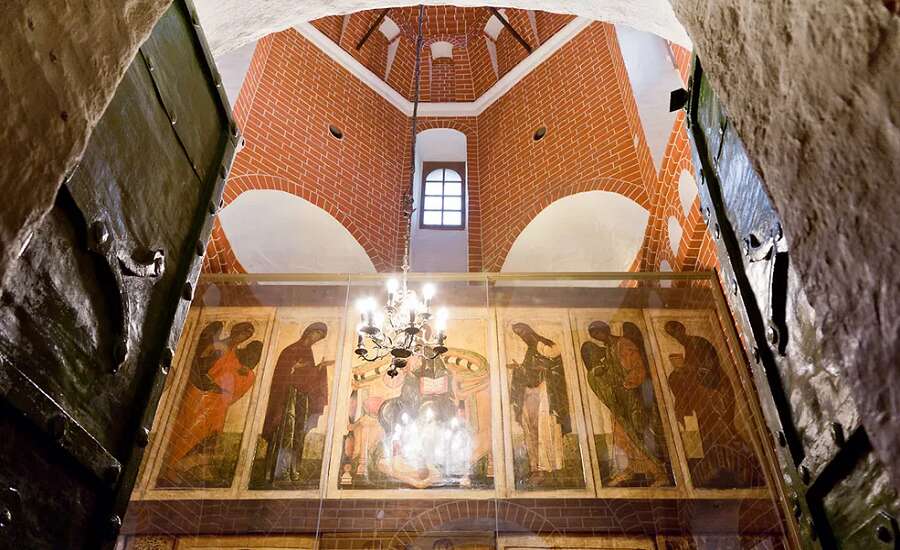
Photo from https://moscowfy.com/
A large church dedicated to Saint Nicholas the Wonderworker, whose revered icon was sailed from Vyatka to Moscow in 1555. This event of great spiritual significance is illustrated through murals, and the church’s iconostasis depicts Saint Nicholas’s life. The decoration of this chapel is particularly rich, with colourful paintings reaching to the ceiling and an iconostasis embellished with floral motifs in gilded stucco. The exterior dome is covered with red and white zig-zag stripes.
Another of St Basil’s small chapels, crowned with a dome of green and yellow triangles. It glorifies Saint Varlaam Khutynsky, an ascetic revered by Ivan IV and his father as the patron saint of the imperial family. The saint’s day, 6th November, marks Ivan’s victorious return to Moscow in 1552. The iconostasis is decorated with icons from 16th-18th centuries and of particular interest is a large hanging icon, The Vision of the Sexton of Tarasia, depicting the prediction ofa series of disasters befalling Novgorod. This icon is fascinating as it is the first artwork in the history of ancient Russian art to depict a whole city; Novgorod is rendered with striking topographic accuracy.
The eleventh and final church of the cathedral ensemble, only reopened to visitors in November 2018. The chapel was consecrated in honour of Saint John, a holy fool, and houses a gilded iconostasis, the relics of the saint, and a small exhibit of religious items and artwork.

Photo from https://moscowfy.com/
Added to the cathedral’s ensemble in the late 1600s, and slightly detached from the main structure. It is topped with a steep octagonal tent lined with small windows and multicoloured tiles. On the southern wall of the bell tower is an enormous and famous icon, The Veil with Basil and John the Blessed.
There are several themed and general excursions available to book at St Basil’s Cathedral, but for an enjoyable and informative day out, why not take Express to Russia’s private Moscow tour, which includes a visit to this magnificent monument.
Address and Contact Details
Red Square, Moscow, 109012
https://shm.ru/museum/hvb/
Metro: Okhotny Ryad (550m),Ploshchad Revolutsii (650m),Teatralnaya (700m)
Tel: +7 (495) 698-33-04
Opening Hours
10:00-18:00 from June to August
11:00-18:00 from May, September, October
11:00-17:00 from November to April
Closed on the first Wednesday of each month
Join us on Facebook
We invite you to become a fan of our company on Facebook and read Russian news and travel stories. To become a fan, click here.
Join our own Russian Travel, Culture and Literature Club on Facebook. The club was created to be a place for everyone with an interest in Russia to get to know each other and share experiences, stories, pictures and advice. To join our club, please follow this link.